Religion in Sudan
| Part of Culture of Sudan |
 |
| Languages |
|---|
| Cuisine |
| Sport |
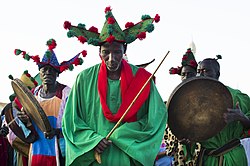
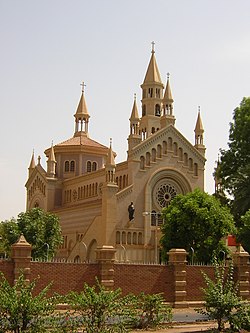
The dominant religion in Sudan is Islam practiced by around 90.7% of the nation's population. Christianity is the largest minority faith in country accounting for around 5.4% of the population.[2] A substantial population of the adherents of traditional faiths is also present.
The ancient
Islam
Up until 2010 (before the secession of South Sudan in 2011), the country was 80% Muslim; as of 2015, the proportion grew to 97%.[8] Most
Sunni Islam in Sudan is not marked by a uniform body of belief and practice, however. Some Muslims opposed aspects of Sunni orthodoxy, and rites having a non-Islamic origin were widespread, being accepted as if they were integral to Islam, or sometimes being recognized as separate. A great majority of Muslims in Sudan adhere to Sufism or are heavily influenced by it, making Sudan one of the most tolerant Muslim majority countries in the world.[9]
Five pillars

Sunni Islam requires of the faithful five fundamental obligations that constitute the
Most
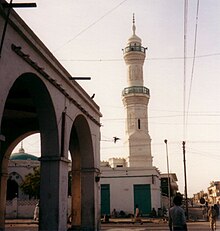
The pilgrimage to Mecca is less costly and arduous for the Sudanese than it is for many Muslims. Nevertheless, it takes time (or money if travel is by air), and the ordinary Sudanese Muslim has generally found it difficult to accomplish, rarely undertaking it before middle age. Some have joined pilgrimage societies into which members pay a small amount monthly and choose one of their number when sufficient funds have accumulated to send someone on the pilgrimage. A returned pilgrim is entitled to use the honorific title hajj or hajjih for a woman.
Another ceremony commonly observed is the great feast
Islam imposes a standard of conduct encouraging generosity, fairness, and honesty towards other Muslims. Sudanese Arabs, especially those who are wealthy, are expected by their coreligionists to be generous.
Islam in Sudanese law
In accordance with
In Sudan (until 1983) modern criminal and civil, including commercial, law generally prevailed. In the north, however, the sharia was expected to govern what is usually called family and personal law, i.e., matters such as marriage, divorce, and inheritance. In the towns and in some sedentary communities sharia was accepted, but in other sedentary communities and among
In September 1983, Nimeiri imposed the sharia throughout the land, eliminating the civil and penal codes by which the country had been governed in the twentieth century. Traditional Islamic punishments were imposed for theft, adultery, homicide, and other crimes. The zealousness with which these punishments were carried out contributed to the fall of Nimeiri. Minority rights are severely restricted under Sharia.[citation needed]
In July 2020, a number of these laws were repealed,[10] including the one that had provided for the death sentence for apostasy,[11] the renouncement of Islam by a Muslim.
Other influences
Islam is a
In Sudan as in much of African Islam, the cult of the saint is of considerable importance, although some Muslims would reject it. The development of the cult is closely related to the presence of the religious orders; many who came to be considered saints on their deaths were founders or leaders of religious orders who in their lifetimes were thought to have barakah, a state of blessedness implying a spiritual power inherent in the religious office. Baraka intensifies after death as the deceased becomes a wali (literally friend of God, but in this context translated as saint). The tomb and other places associated with the saintly being become the loci of the person's baraka, and in some views he or she becomes the guardian spirit of the locality. The intercession of the wali is sought on a variety of occasions, particularly by those seeking cures or by barren women desiring children. A saint's annual holy day is the occasion of a local festival that may attract a large gathering.
Better-educated Muslims in Sudan may participate in prayer at a saint's tomb but argue that prayer is directed only to God. Many others, however, see the saint not merely as an intercessor with and an agent of God, but also as a nearly autonomous source of blessing and power, thereby approaching "popular" as opposed to orthodox Islam.
Movements and religious orders
Islam made its deepest and longest lasting impact in Sudan through the activity of the Islamic religious brotherhoods or orders. These orders emerged in the Middle East in the twelfth century in connection with the development of Sufism, a reaction based in mysticism to the strongly legalistic orientation of mainstream Islam. These orders first came to Sudan in the sixteenth century and became significant in the eighteenth. Sufism seeks its adherents a closer personal relationship with God through special spiritual disciplines. The exercises (or dhikr) include reciting prayers and passages of the Qur'an and repeating the names, or attributes, of God while performing physical movements according to the formula established by the founder of the particular order. Singing and dancing may be introduced. The outcome of an exercise, which lasts much longer than the usual daily prayer, is often a state of ecstatic abandon.
-
A dervish
-
A Dancing dervish
-
A dervish from the 1920s
-
Sufis performing a ritual in Khartoum
A mystical or devotional way (sing. tariqa; pl. turuq) is the basis for the formation of particular orders, each of which is also called a tariqa. The specialists in religious law and learning initially looked askance at Sufism and the Sufi orders, but the leaders of Sufi orders in Sudan have won acceptance by acknowledging the significance of the sharia and not claiming that Sufism replaces it.
The principal turuq varies considerably in their practice and internal organization. Some orders are tightly organized in a hierarchical fashion; others have allowed their local branches considerable autonomy. There may be as many as a dozen Turuq in Sudan. Some are restricted to that country; others are widespread in Africa or the Middle East. Several Turuq, for all practical purposes independent, are offshoots of older orders and were established by men who altered in major or minor ways the tariqa of the orders to which they had formerly been attached.
The oldest and most widespread of the turuq is the
Much different in organization from the other brotherhoods is the

The Khatmiyyah had its center in the southern section of Ash Sharqi State and its greatest following in eastern Sudan and in portions of the riverine area. The Mirghani family were able to turn the Khatmiyyah into a political power base, despite its broad geographical distribution, because of the tight control they exercised over their followers. Moreover, gifts from followers over the years have given the family and the order the wealth to organize politically. This power did not equal, however, that of the Mirghanis' principal rival, the Ansar, or followers of the Mahdi, whose present-day leader was Sadiq al-Mahdi, the great-grandson of Muhammad Ahmad, who drove the Egyptian administration from Sudan in 1885.
Most other orders were either smaller or less well organized than the Khatmiyyah. Moreover, unlike many other African Muslims, Sudanese Muslims did not all seem to feel the need to identify with one or another tariqa, even if the affiliation were nominal. Many Sudanese Muslims preferred more political movements that sought to change Islamic society and governance to conform to their own visions of the true nature of Islam.

One of these movements,
In the century since the Mahdist uprising, the neo-Mahdist movement, and the Ansar, supporters of Mahdism from the west, have persisted as a political force in Sudan. Many groups, from the
A movement that spread widely in Sudan in the 1960s, responding to the efforts to secularize Islamic society, was the Muslim Brotherhood (Al Ikhwan al Muslimin). Originally the Muslim Brotherhood, often known simply as the Brotherhood, was conceived as a religious revivalist movement that sought to return to the fundamentals of Islam in a way that would be compatible with the technological innovations introduced from the West. Disciplined, highly motivated, and well-financed the Brotherhood became a powerful political force during the 1970s and 1980s, although it represented only a small minority of Sudanese. In the government that was formed in June 1989, following a bloodless coup d'état, the Brotherhood exerted influence through its political wing, the National Islamic Front (NIF) party, which included several cabinet members among its adherents.
Christianity
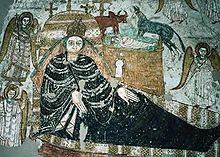
Sudan was predominantly
Roman Catholicism
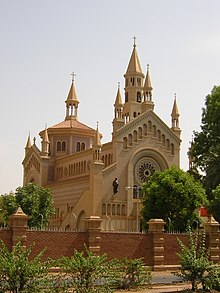
There were approximately 1.1 million Catholics in (pre-partition) Sudan, about 3.2 percent of the total population.[16] Sudan forms one ecclesiastical province, consisting of one archdiocese (the Archdiocese of Khartoum) and one suffragan diocese (the diocese of El Obeid). The vast majority of Sudan's Catholics ended up in South Sudan after the partition.
Indigenous religions
Each
The concept of a high spirit or divinity, usually seen as a creator and sometimes as ultimately responsible for the actions of lesser spirits, is common to most Sudanese groups. Often the higher divinity is remote, and believers treat the other spirits as autonomous, orienting their rituals to these spirits rather than to the high god. Such spirits may be perceived as forces of nature or as manifestations of ancestors. Spirits may intervene in people's lives, either because individuals or groups have transgressed the norms of the society or because they have failed to pay adequate attention to the ritual that should be addressed to the spirits.
The notions of sorcery are to be found in varying forms among peoples, including nomadic and other Arabs, who consider themselves Muslims. A specific belief widespread among Arabs and other Muslim peoples is the notion of the evil eye. Although a physiological peculiarity of the eye (walleye or cross-eye) may be considered indicative of the evil eye, any persons expressing undue interest in the private concerns of another may be suspected of inflicting deliberate harm by a glance. Unlike most witchcraft, where the perpetrator is known by and often close to the victim, the evil eye is usually attributed to strangers. Children are thought to be the most vulnerable.
Ways exist to protect oneself against sorcery or the evil eye. Many
Irreligion
The true number of atheists or agnostics in Sudan is unknown, due to fear and prejudice suffered by non-Muslims.[17][18] Prior to July 2020, when Sudan's law against apostasy was repealed,[10] atheists faced the death penalty if they were born to a Muslim father, or had accepted Islam at some point and then renounced it.[19][20][21]
Hinduism
According to ARDA, Sudan had 862 Hindus in the year 2010.[22]
Religious freedom
Although the 2005 Interim National Constitution (INC) provides for
See also
- Islam in Sudan
- Sunni Islam in Sudan
- Christianity in Sudan
- Orthodoxy in Sudan
- Catholic Church in Sudan
- Protestantism in Sudan
References
 This article incorporates text from this source, which is in the public domain. Country Studies. Federal Research Division.
This article incorporates text from this source, which is in the public domain. Country Studies. Federal Research Division.
- ^ "Religions in Sudan | PEW-GRF". Pew-Telmpleton: Global Religious Futures Project. Pew Research Center. Archived from the original on 2017-02-02. Retrieved 2020-07-26.
- ^ "Religions in Sudan | PEW-GRF". www.globalreligiousfutures.org. Retrieved 2020-07-26.
- ^ "Sudan ends 30 years of Islamic law by separating religion, state". 6 September 2020.
- ^ "Sudan separates religion from state ending 30 years of Islamic rule". 7 September 2020.
- ^ "Islamic world at decisive point in history: Will it take the path of Emirates or Turkey?". 6 September 2020.
- ^ Minority Rights Group International, World Directory of Minorities and Indigenous Peoples - Sudan : Copts, 2008, available at: http://www.unhcr.org/refworld/docid/49749ca6c.html Archived 17 October 2012 at the Wayback Machine [accessed 21 December 2010]
- ^ "Sudan scraps apostasy law and alcohol ban for non-Muslims". BBC News. 12 July 2020.
- ^ "Sudan - World Directory of Minorities & Indigenous Peoples". 19 June 2015.
- ^ "Salafis vs Sufis: A Simmering Conflict in Sudan". Al Akhbar English. 2012-03-14. Retrieved 2016-03-09.
- ^ a b "Sudan reforms strict Islamist laws after 30 years". BBC News. 2020-07-12. Retrieved 2020-07-26.
- ^ Sheen, J. (1997). Freedom of Religion and Belief: A World Report. Routledge, p. 76.
- ^ Sheen, J. (1997). Freedom of Religion and Belief: A World Report. Routledge, p. 75.
- ^ Brock, Laurie (2013-05-16). "The Martyrs of Sudan: Yesterday, Today, Tomorrow | 50 Days of Fabulous". 50days.org. Retrieved 2016-03-09.
- ^ "Crisis in Sudan: Allegations of Ethnic Cleansing in the Nuba Mountains". The New York Times. 24 June 2011. Retrieved 2016-03-09.
- ^ Boswell, Alan (2011-06-14). "Darfur Redux: Is 'Ethnic Cleansing' Occurring in Sudan's Nuba Mountains? - TIME". Time. Retrieved 2016-03-09.
- ^ Cheney, David M. "Structured View of Dioceses in Africa [Catholic-Hierarchy]". Catholic-hierarchy.org. Retrieved 2016-03-09.
- ^ "Sudan's president warns of tighter Islamic law". CNN. Retrieved 2013-11-06.
- ^ "Sudanese centre says incidents of apostasy, atheism increasing in country". Sudan Tribune. Retrieved 2013-11-06.
- ^ "Sudan: A misconception of apostasy". Al Jazeera. Retrieved 2014-05-18.
- ^ "Sharia in Sudan v. women and religious freedom | Washington Times Communities". Communities.washingtontimes.com. 2013-11-24. Retrieved 2013-11-28.
- ^ Fisher, Max (10 December 2012). "The seven countries where the state can execute you for being atheist". The Washington Post. Retrieved 16 December 2012.
Though that list includes some dictatorships, the country that appears to most frequently condemn atheists to death for their beliefs is actually a democracy, if a frail one: Pakistan. Others include Saudi Arabia, Iran, Afghanistan, Sudan, the West African state of Mauritania, and the Maldives, an island nation in the Indian Ocean.
- ^ "Most Hindu Nations (2010)". QuickLists > Compare Nations > Religions >. The Association of Religion Data Archives. 2010. Retrieved February 20, 2022.
- ^ "20050316_Sudan_Draft_Constitutional_Text". Archived from the original on June 10, 2007. Retrieved March 15, 2012.




